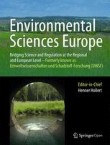Citation Impact 2023
Journal Impact Factor: 6.0
5-year Journal Impact Factor: 6.5
Source Normalized Impact per Paper (SNIP): 1.691
SCImago Journal Rank (SJR): 1.364
Speed 2023
Submission to first editorial decision (median days): 9
Submission to acceptance (median days): 93
Usage 2023
Downloads: 1,456,609
Altmetric mentions: 1,355
Chronic toxicity testing including transcriptomics-based molecular profiling in Cloeon dipterum
The so-called EPT taxa have been shown to be highly sensitive to various environmental pollutants. However, there are only few published studies on toxicity testing with EPT representatives and there is a part...





